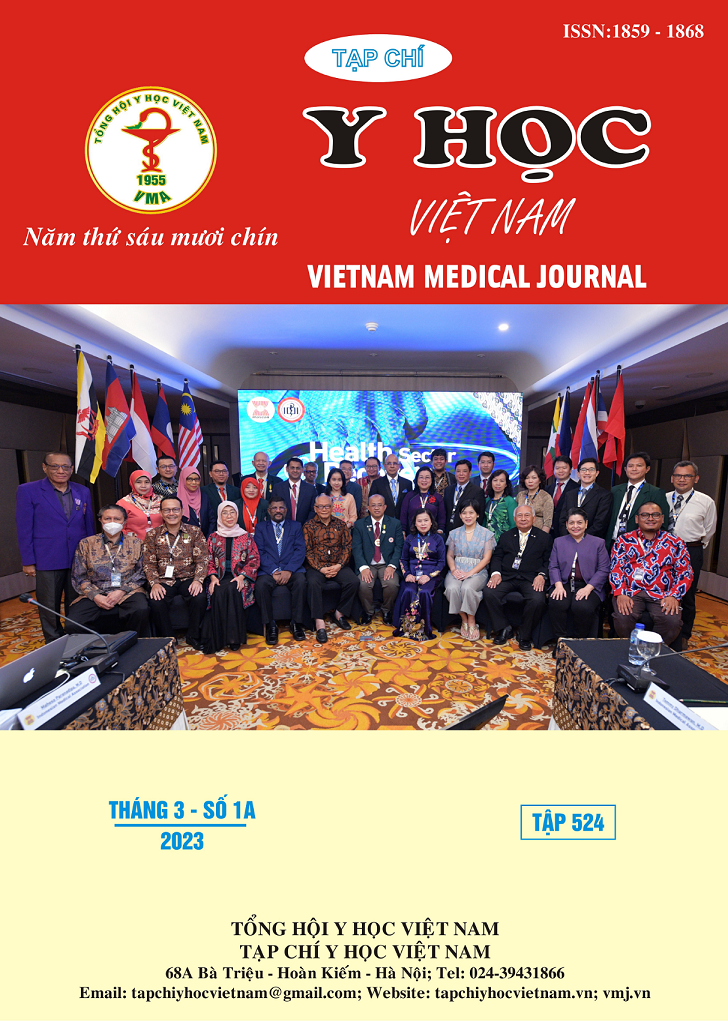NGHIÊN CỨU VAI TRÒ CAGPAI CỦA HELICOBACTER PYLORI Ở BỆNH NHÂN UNG THƯ DẠ DÀY
Nội dung chính của bài viết
Tóm tắt
Đặt vấn đề: Tính nguyên vẹn của đảo bệnh sinh cag (cagPAI) của H. pylori được nhiều nghiên cứu cho thấy có liên quan với nguy cơ ung thư dạ dày (UTDD). Tuy nhiên, các kết quả nghiên cứu còn chưa thống nhất. Mục tiêu: Nghiên cứu mối liên quan giữa cagPAI của H. pylori với UTDD tại Việt Nam. Đối tượng & phương pháp: Nghiên cứu cắt ngang 179 bệnh nhân (89 bệnh nhân UTDD và 90 bệnh nhân viêm dạ dày mạn) nhiễm H. pylori. Chẩn đoán UTDD và viêm dạ dày mạn (VDDM) dựa trên mô bệnh học. Xác định sự hiện diện của cagPAI thông qua ba gen cagA, cagE, cagT bằng kỹ thuật Realtime-PCR. Kết quả: 100% các chủng H. pylori mang gen cagPAI dương tính, trong đó tỷ lệ H. pylori mang gen cagPAI nguyên vẹn là: 126/179 (70,4%). Nhóm UTDD có tỷ lệ cagPAI nguyên vẹn cao hơn so với nhóm VDDM (79,8% so với 61,1%), sự khác biệt có ý nghĩa thống kê (OR = 2,5; p < 0,01). Ở bệnh nhân UTDD: Không có sự khác biệt về tỷ lệ nhiễm H. pylori mang gen cagPAI theo nhóm tuổi, theo giới, đặc điểm đại thể trên nội soi (theo phân loại Borrmann) và trên mô bệnh học (theo phân loại Lauren). Kết luận: Tỷ lệ cagPAI của H. pylori nguyên vẹn ở bệnh nhân UTDD cao hơn so với tỷ lệ cagPAI ở bệnh nhân VDDM.
Chi tiết bài viết
Từ khóa
cagPAI, Helicobacter pylori, ung thư dạ dày, viêm dạ dày mạn
Tài liệu tham khảo
2. Kusters Johannes G, Arnoud HM Van Vliet, and Ernst J Kuipers (2006), "Pathogenesis of Helicobacter pylori infection", Clinical microbiology reviews. 19(3), p. 449-490.
3. Fischer Wolfgang, Jürgen Püls, Renate Buhrdorf, et al (2001), "Systematic mutagenesis of the Helicobacter pylori cag pathogenicity island: essential genes for CagA translocation in host cells and induction of interleukin‐8", Molecular microbiology. 42(5), p. 1337-1348.
4. Ikenoue T., S. Maeda, K. Ogura, et al (2001), "Determination of Helicobacter pylori virulence by simple gene analysis of the cag pathogenicity island", Clin Diagn Lab Immunol. 8(1), p. 181-186.
5. Khatoon J, KN Prasad, R Prakash Rai, et al (2017), "Association of heterogenicity of Helicobacter pylori cag pathogenicity island with peptic ulcer diseases and gastric cancer", Br J Biomed Sci. 74(3), p. 121-126.
6. Day Andrew S, Nicola L Jones, Jennifer T Lynett, et al (2000), "cagE Is a Virulence Factor Associated with Helicobacter pylori—Induced Duodenal Ulceration in Children", The Journal of infectious diseases. 181(4), p. 1370-1375.
7. Mattar Rejane, Sergio Barbosa Marques, Maria do Socorro Monteiro, et al (2007), "Helicobacter pylori cag pathogenicity island genes: clinical relevance for peptic ulcer disease development in Brazil", Journal of medical microbiology. 56(1), p. 9-14.
8. Nguyen LT, T Uchida, Y Tsukamoto, et al (2010), "Clinical relevance of cagPAI intactness in Helicobacter pylori isolates from Vietnam", European journal of clinical microbiology infectious diseases. 29(6), p. 651-660.
9. Nilsson C., A. Sillén, L. Eriksson, et al (2003), "Correlation between cag pathogenicity island composition and Helicobacter pylori-associated gastroduodenal disease", Infect Immun. 71(11), p. 6573-6581.
10. Amieva M. and R. M. Peek, Jr. (2016), "Pathobiology of Helicobacter pylori-Induced Gastric Cancer", Gastroenterology. 150(1), p. 64-78.


